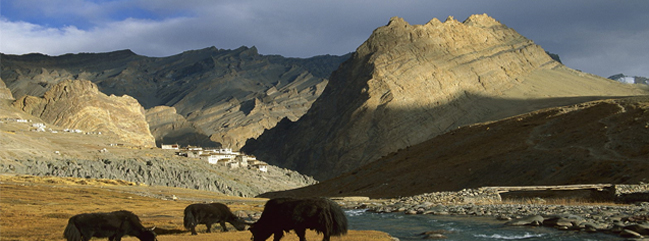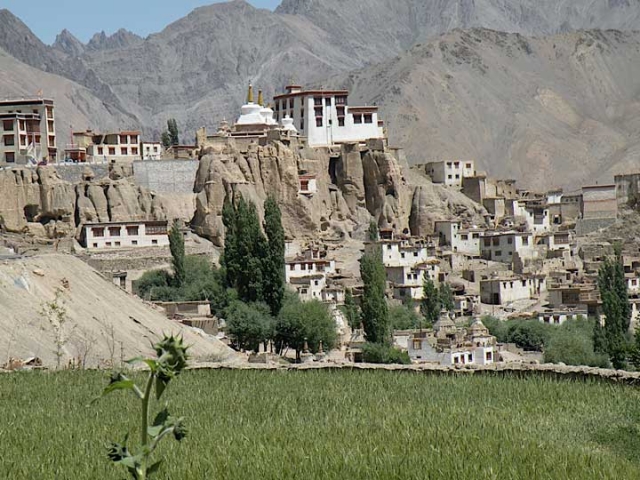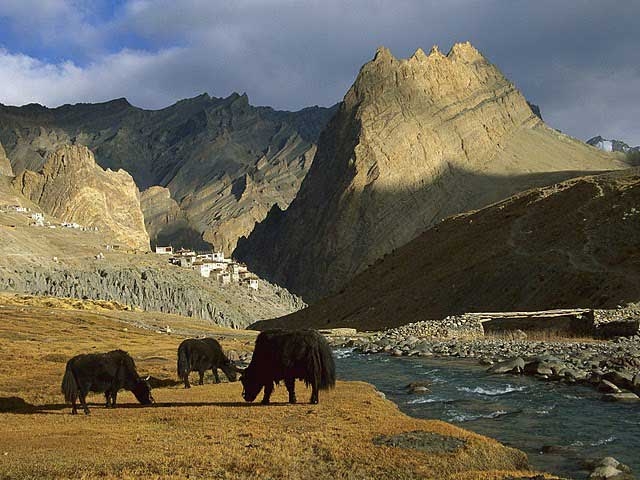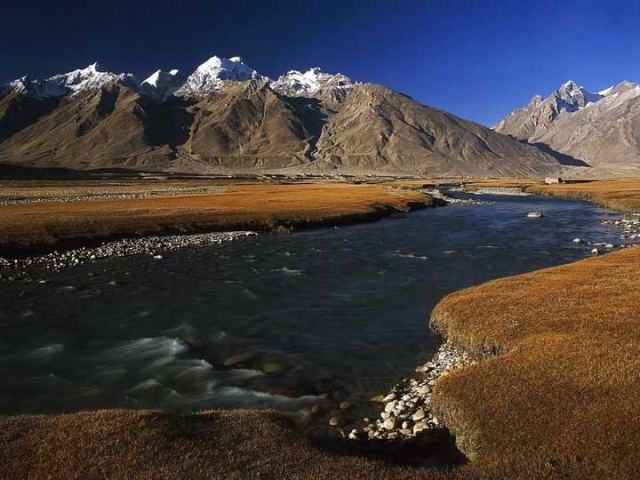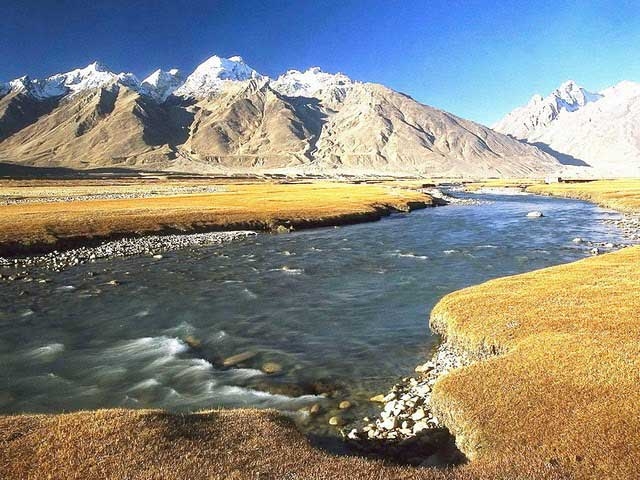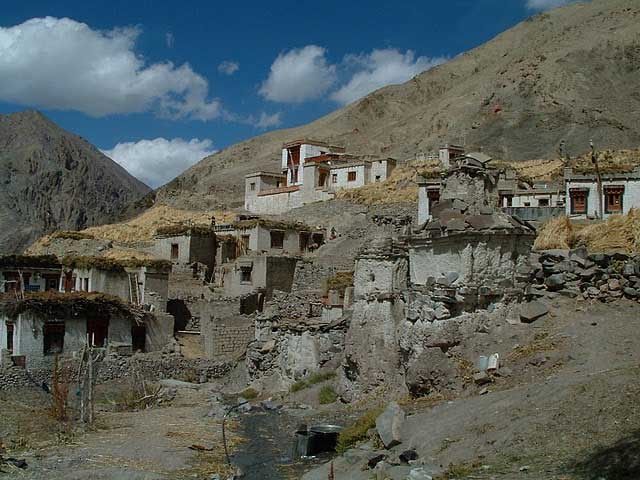Towards the western end of the Himalayas a series of continuous mountain ridges, comprising scores of 6000 metre (20000 foot) peaks, forms an effective barrier between the Indian provinces of Lahaul and Ladakh. Linking these contrasting mountainous regions is a trekking route that provides one of the great challenges of the Indian Himalaya. Transferring by train and car from Delhi, we pass through the lush Kulu Valley and cross the Rohtang Pass to reach the start of our trek at Darcha. From here, we head north across the Shingo La (c.5100m./16000ft.) into the ancient kingdom of Zanskar, famous for its hardy inhabitants and starkly beautiful landscape. En route, we encounter a succession of isolated villages and several wonderful Buddhist monasteries, notably at Phuktal, Lingshet and Lamayuru. As a finale to what is unquestionably one of the world’s classic trekking experiences, there is also time to explore the fascinating Ladakhi capital of Leh.
Day 01 : Arrival Delhi :
There you will be met by our Airport Representative and transferred to hotel by private tourist vehicle. Overnight at hotel.
Day 02 : Delhi Sightseeing :
After breakfast commence the fullday Old & New Delhisightseeing Am visit Jama Mosque, Red Fort, Rajghat (Cremination Side) & Government Building as India Gate, Parlimament House, & Indian President House. After lunch explor the Humayun Tomb, & Qutub Minar, drive back to hotel for overnight.
Day 03 : Delhi / Kalka / Manali (1985M) :
Early morning train to Kallka ETD 0740 hrs Arr. 1200hrs. By Shtabadi Express, on arrival at Kalk train station meet to escort commence drive to Manali 280km/ 7-8 hrs. On arrival check into Hotel. Dinner & overnight at Hotel.
Day 04 : Drive from Delhi to Manali :
After breakfast at 0830 hrs, commence half-day tour in & around Manali the “queen of the mountain” situated at an altitude of 1985m. (6730ft) On the west bank of the Bias River, it makes an idyllic stop before heading on over the Rohtang pass the barren mountain landscapes beyond to Lahaul & Ladakh. First we take the excursion to Naggar, 22 kms from Manali, Naggar the former capital of the Kings of Kullu. Perched on a mountainside, the 400-year-old castle, built of weathered wood & stone is now a tourist hotel. It has several stone temples dedicated to Shiva & Mandi. Later also walk up to visit the Rhoerich art Gallery, situated above the village with beautiful paintings. Return to Manali after visit; en route stop to visit the village of Jagatsukh. Rest of the afternoon free to walk around the town to visit three km north is the attractive village of old Manali, its peaceful surroundings, a good view from there the main city of Manali, Vashist, 03 km north-east of Manali, although the main reason for visiting is to soak in the hot springs. The site of ancient temples & the Shiva temple in Shikhara style and nearby old Devi Sharvali temple, dedicated to the goddess Gayatri (a sister of Durga) walk one km from the heart of the town and visit the 600 years old Hadimba Devi temple with a four tiered pagoda shaped roof, a somber, wooden shrine set in a cedar grove. According to the Mahabharata Bhima, who wanted to marry Hadimba, first had to kill cruel demon brother Hadimba that he did in this grove. Another exterior and door covered with handsome carvings received a dubious token of gratitude from the king. He was so enormed with the results, he cut off the artist’s hand to prevent him from duplicating another temple that might rival the Hadimba. The influx of Tibetan refugees in Manali has left its stamp on the town. The new Tibetan monastery just behind the bus stop, in an area called model town and adjoining it the Tibetan bazaar, are examples. Farther north from Manali is Kothi, is quite village at the foot of the Rohtang pass. Offering the dramatic views of massive snow-covered peaks. Dinner & overnight at hotel.
Day 05 : Manali / Keylong /Jispa(3182M)122 km/06 hrs drive:
After breakfast commence drive to Keylong the capital village of this valley, Keylong is a bustling village & a very interesting market. Walk around Keylong & time permitting walk on the other side of the hill stands the most celebrated monastery of Lahaul called Khardung. Late afternoon drive to Jispa for overnight camp.
LadakhDay 06 : Jispa / Palamo(Chhalang-Topko)(358 0m) Trek 5 Hrs. (Start the Trek)
This trek starts from the Himachal region and ends in the Ladakh region. Darcha is a village in the Lahaul valley of Himachal region and is the gateway to the Zanskar valley in the Ladakh region. Trek to Palamo (Chhalang Topko) passing through two Himachal villages Chhika & Rarik, now the road is leading till Palamo bridge, but it is better to do trek till Palamo, not by drive, dinner & overnight camp.
Day 07 : Palamo (Chhalang Topko) / Zanskar Sumdo (3750m): Trek 5-6 Hrs
The trail gradually ascends till reaching the awesomely beautiful Zanskar Sumdo, which is the meeting point of two water sources. The river here was once dangerous to cross but is now made safe by a modern suspension bridge. The pack cannot cross on it and therefore must be unloaded so that they can swim through the river. This bridge is situated on the boundaries of Zanskar and Lahaul valleys and from here you entire the Zanskar valley. From here ascend a little further to reach Zanskar Sumdo where you camp overnight.
Day 08 : Zanskar Sumdo To Chhumiknakpo (4060m) Trek 5-6 Hrs
Trek towards the stream flowing from Shingo La Pass. The initial stretch towards Shingo La Pass has to be trekked very slowly, as the trail is steep and high altitude. A number of streams have to be crossed on the trail, which are extremely cold and have to be crossed very cautiously and slowly. The first campsite is a pasture called Chhumiknakpo. Overnight at camp.
Day 09 : Chhumiknakpo/Lakong (4400m) over Shingo La (5100m) Trek 7 hrs.
The trail steeply ascends along a stream and then after further ascending across a snow-filled path, reaches Shingo La Pass. From the top of the Pass, there are spectacular views of the peaks of Ladakh. >From this pass, the trail initially descends steeply down till the meadows of Lakong, which is a good camping site at the foot of the Shingo La. overnight dinner & camp.
Day 10 : Lakong / Kargyak (4060 m) 5-6 Hrs
The trail descends along the wide Kargyak River, which is difficult to cross if there has been a lot of snow melting during the day, increasing the depth of the water. After crossing the river, continue down the valley past the beautiful sheer-sided mountain called Gumburanjon (5900m). Kargyak is the first and highest village in this valley. There are good campsites beneath this village.
Day 11 : Kargyak / Kuru / Testa / Purne (3745 m) Trek 6-7 Hrs
The trail gradually descends and runs along little settlements. The houses in this region are very simple compared to the elaborate architecture found in other parts of Zanskar valley. The houses are built below ground level to keep them insulated during the long cold winter months. Trek along these little villages, Kuru or Teta. From herefollow the Kargyak River down the valley till Purne village. This village has a good campsite and one can even take a side trip to Phuktal. Overnight camp.
Day 12 : Purni /Phuktal Gompa / Purni : (3745m) Trek 5-6 Hrs
After a leisurely breakfast commence excursion to the most famous & dramatic monastery of Phuktal which in one the most impressive Gompas in Ladakh by covering approx 14 kms. Where the spectacular Gelukpa monastery is situated around a sacred spring that originates from a deep cave. It is a fantastic sight with the monastery buildings built on the face of a rock, while the temple is situated in the cave. Trek back to Purne after visiting the monastery to camp for lunch. Dinner & overnight camp.
Day 13 : Purni/ Reru / Mune (3650m) Trek 6 – 7 Hrs
The trek gradually descends through this Buddhist region and you will come across a couple of Chortens on the way. So according to custom, always go from the left side of the Chortens, which are stonewalls with religious inscriptions. Reaching Reru village you find the moterable road from Padum to Reru village. Behind the village one small lake and protected forest area the location is top on a small plateau. Continue along the river until you reach the village and monastery of Mune. The friendly monks show you around the monastery. Dinner and overnight camp.
Day 14 : Mune / Padam (3560 m) 6 hrs. (End the Trek)
The trek runs along the river until reaching the Bardan Gompas, which is one of the oldest Gompas of the region. The friendly monks will show you around the Gompas, which also houses a gigantic prayer wheel, which stands over three meters high. After visiting the monastery, trek down till Padum, which is only a little away. Camp overnight.
Day 15 : Rest day at Padam
Padum Full day sightseeing by walk to Karsha & Zangla gompas. Rest of the time explores the local village around the Padum. Overnight at camp.
Day 16 : Padum / Rangdum :
After breakfast drive to Rangdum (4100m) by covering 140 km. On arrival at Rangdum pitch the tent for overnight. Rest of the day explores the monastery.
Day 17 : Rangdum / Suru Valley / Kargil :
Early morning drive to Kargil 7-8 hrs/covering 145 km. Over the Pensila pass (4250m), en-route visit the Nomadic camp, & shepherd houses. Enter the Suru Valley : One of the most beautiful regions of Ladakh , the Suru Valley forms the mainstay of Kargil district. Lying nestled along the north-eastern foothills of the great Himalayan Wall, it extends from Kargil town, first southward for a length of about 75 Kms Upto the expanse around Panikhar, thence eastward for another stretch of nearly 65 kms upto the foot of the Penzila watershed where the Suru valley rises. Its composite population of about 30,000 — mainly of Tibeti-Darad descent– are Muslims who had converted their Buddhist faith around the middle of the 16th century. The upper valley reaches of the valley, particularly around the Sankoo bowl, the Panikhar expense and the higher stretch beyond, present a spectacle of breathtaking features-majestic mountain ramparts crowned by snow capped peaks, undulating alpine slopes draining into wild mountain streams of foaming cascades of pristine water, awesome glaciers descending along the Himalayan slopes to the river bed in riverine formation, Quaint villages of adobe houses straggling dry hillocks surrounded by large tracts of lush crops downward the patches of alpine pastures uphill. The beauty of this region is further enhanced by the sheer contrast provided by the towering peaks of Kun (7035 m)and Nun (7135 m) which loom over the skyline in their crystalline majesty. Dinner & overnight at Hotel.
Day 18 : Kargil / Lamayuru / Leh (3530 m): (245 km. 7-8 hrs drive):
After breakfastdrive towards Leh, enroute visit the historical site of Mulbekh. Later continue drive to Lamayuru. Visit Lamayuru monastery. In the afternoon drive further 1 & Half hrs drive to Leh, ………On arrival check into hotel for overnight.
Day 19 : Leh Sightseeing :
After breakfast visit Phyang & Spituk, Shanker Monastery PM visit Shanti Stupa and strolling the local market for indivudual activites. Overnight at hotel.
Day 20 : Leh Sightseeing :
Full day excursion to visit the most important monasteries of the Indus valley. After breakfast drive toward Hemis around 35 km from Leh, En route visit Shey, Thiksey & Hemis monastery accompanied by local English speaking guide : – Shey was the old capital and the home of the kings of Ladakh before the new capital became established in Leh the palace sits in a strategic position on a spur jutting out into the Indus valley. The main temple contains a large Buddha statue sculpted by Nepalese craft men. Thiksey, this large Gompa is an impressive sight, situated on top of a craggy hill while the rest of the complex sprawls down beneath it. It was founded in the 15th century by Gelukpa monks. On arrival at Hemis visit the richest monasteries in this valley. As his famous annual mosque dance this is very very popular in Leh. After drive to Martselang & trek to Sang Sumdo around 2-3 hrs pitch the tent near by the village & rest of the time explore the village. Late afternoon return to Leh, rest of the day at leisure for shopping etc.
Day 21 : Leh / Delhi :
Early morning transfer to Leh airport for flight to Delhi (ETD 0735 hrs ETA 0850 hrs). On arrival transfer to Hotel. Day at leisure!!! Overnight at hotel.
Day 22 : Final Departure :
After breakfast day at leisure to explore the city. Checkout 1200 hrs. Late evening in time transfer to international airport for flight to onward destination.
NOTE: The above information is a guide and standard template of what we provide. The trek can be customized at your request to accommodate your specific requirements.
Note : On adventure trips of this type, weather, local politics, transport or a multitude of other factors beyond our control can result in a change of itinerary. It is, however, very unlikely that the itinerary would be substantially altered; if alterations are necessary the leader will decide what is the best alternative, taking into consideration the best interests of the whole group. Where a change does occur, we do everything we can to minimize its effect, but we cannot be responsible for the results of changes or delays.
Q.What type of shape do I need to be in, is this trip for me?
A. Trekking is suitable for average people who are moderately fit, thus no previous experience is required. Some physical fitness programs such as running, swimming, hiking is recommended before you embark on your journey. Persons suffering from a pre-existing medical condition or disease must seek medical advice before considering the trek. Whilst on the trek, it is common to experience some discomfort before being fully acclimatized.
To prepare for a strenuous trek you should begin training at least two to three months before your departure. As a guideline, an hour of aerobic exercise three to four times per week would be considered a minimum requirement. The best preparation is bushwalking involving relatively steep ascents and descents. If you can manage a couple of valley floor to ridgeline ascents per comfortable and able to enjoy the trek to the fullest. They are physically strong, sharp-witted and have an incredibly positive attitude towards a life that we would consider extremely tough. There is something about a trek in the Himalaya that draws you back time and time again. For keen walkers it is a paradise and even avowed non-walkers find that one foot just seems to follow the other, drawn by the appeal of what lies beyond.
Q. Will somebody come to pick me up at the Airport upon my arrival?
A. Yes, our Airport Representative will be there to greet you outside of Terminal Hall, he/she will be displaying an Kiwi Adventures Treks & Expedition sign board. Upon arrival, you will be transferred to your hotel.
Q. What sort of accommodation can I expect in Kathmandu and in trekking?
A. 11 night’s Trekking Guesthouse, 4 nights three/four star hotels in Kathmandu.
We use standard rooms from three/four star hotels in Kathmandu with breakfast included. Along the trekking routes teahouses/Lodges generally provide basic clean facilities with a mattress and a quilt or blanket. We can also offer you sleeping bags if needed (which need to return after the trip) but it is a good idea to always have your own sleeping equipment. We usually provide single and double rooms as well as the occasional dormitory. The dining room is downstairs around a fire. All food will be cooked to order in the little kitchen. You should not enter the kitchen unless asked to do so.
Q. What sort of food can I expect in trekking?
A. In trekking most teahouses (lodges) cook a delicious range of mostly vegetarian fare. Pasta, tuna bakes, noodles, potatoes, eggs, dhal bhat, bread, soups, fresh vegetables (variety depends on the season) and even some desserts like apple pies, pancakes, and some interesting attempts at custard. You will find a lot of garlic on the menu because it assists with acclimatization – eat some every day. In many larger villages you may find some meat on the menu. You can always get hot chocolate, tea, and hot lemon drinks, as well as soft drinks, and treats like chocolate and crisps.
Each day dinner and breakfast are used to take in the same lodge you spend the night. Lunch will be taken on the way to destination.
Q. What sort of transportation you use?
A. Kiwi Adventures Treks & Expedition is all about providing you with local insights as well as adventure, with that in mind, where we think you will get more out of your holiday by using different means of transport that is what we do. Using a variety of private transport is an integral part of our Himalaya tours and enhances the experience!
We use private tourist vehicles for sightseeing, city tours and pickups. Depending on the group size we use cars, minibus, van or land cruiser. These small light vehicles are more manoeuvrable and flexible enabling us to take you through the Narrow roads of Nepal. All the vehicles are usually air-conditioned unless we are travelling in cooler areas.
Q. What is the best season for this trekking?
A. Our trekking season extends from mid- September to May. From early September the monsoonal rains decrease. By end of September through to December the weather is usually stable with mild to warm days, cold nights. February, March, April, May, October, November, December are the best time to do trek.
Q. What is the weather & temperature like in trekking?
A. Weather in the mountains is notoriously difficult to predict. At night it is generally cooler the days are generally warm. Winter (January and February) will be bit colder but the days can be quite beautiful and warm if the sun is out. There will be bit of snow during the month of January, February and December. It is also important to make sure that you can stay warm and dry in just about any conditions. Expect the unexpected! The temperature could be as high as 20 deg C to -15 deg C low.
Q. Can I charge my digital camera or other batteries on my trip?
A. These facilities will be available in most of the places in your hotel reception by paying some service charges. Remember to bring your adapters!
Q. Is there any communication while we are on trekking?
A. There are telephones in some villages along the trekking routes from which you can make international calls.
Q. Can I use credit cards in the places visit in trekking?
A. In most cities yes, to some extent, however once you leave those cities behind, all you need is cash.
Q. How much additional money do I need per day?
A. In Kathmandu, you can allocate US$ 10 – 25 for a lunch / dinner. It’s all depends on your spending habits. US$7 to 10 US$ a day will be enough to buy bottles of water, chocolates and few drinks in trekking.
Q. Do I need to tip my guide and porters? How much would that be?
A. This is a difficult thing to gauge. We have seen everything from 20USD to 1000 USD per person for guides and porters. Tipping is not required, but a small way to show your guides and local porters thanks for their help. The level of the tip should reflect the level of personal involvement with your guide.
Q. Is the water OK to drink? Do I need to bring purifying tablets/filter?
A. In most places bottled water is readily available. If you wish to drink normal water, you need to use purifying aid, which you will need to bring with you.
Q. Are the Kiwi Adventures Treks & Expedition staff insured?
A. Our company insures all our trekking staff, including guide, cook, sherpa and porters.
Q. What essential documents do I need to bring with me on tour?
A. *Valid Passport – must be valid for up to 6 months after you return from your tour, keep a separate photocopy.
*Travel insurance, keep a separate photocopy
*Cash and Traveller’s Cheques, keep numbers and proof of purchase separate
*Flight tickets
*Emergency contact numbers for T/C’s, banks, insurance, family contacts.
Q. Can I add extra days to my trekking trip?
A. A hoilday should never be about making it to the final point quickly. Along your trek we can add days at your request with additional costs to cover guides, porters, accommodation and food.
Q. Do you use yaks/porters on the trek or do we carry all of our own gear?
A. Whilst on the trek, our porter will take care of your luggage. All you need to carry is your small day bag for your personal belongings like camera, water bottle, sun cream etc only.
Q. What opportunities will I have for shower along the trek?
A. In major places, we arrange guesthouse with hot shower. And in rest of the places, hotel water in bucket will be provided for shower; it would cost you extra about USD 3-4 per shower.
Q. Do you know about how many total miles the trek is?
A. Total distance of the entire trek is about 75 miles.
Cost Includes
• Airport Pickup and Drop
• Hotels in Delhi, Manali & Leh
• Domestic flights, local departure tax
• Group transportation by private vehicle
• ‘Kamzang’ expedition-style trekking:
• Delicious meals,
• Fresh coffee & gourmet teas,
• Horse portering,
• Western & Sherpa guides,
• Local staff, single,
• Roomy Marmot & Big Agnes tents (double for couples) &
Cost Excludes
• Meals in Delhi, Manali & Leh (while not on trek)• travel or travel health insurance,
• India visa,
• International flights,
• Equipment rental,
• Alcohol and bottled drinks,
• Laundry,
• Tipping and other items of a personal nature.
